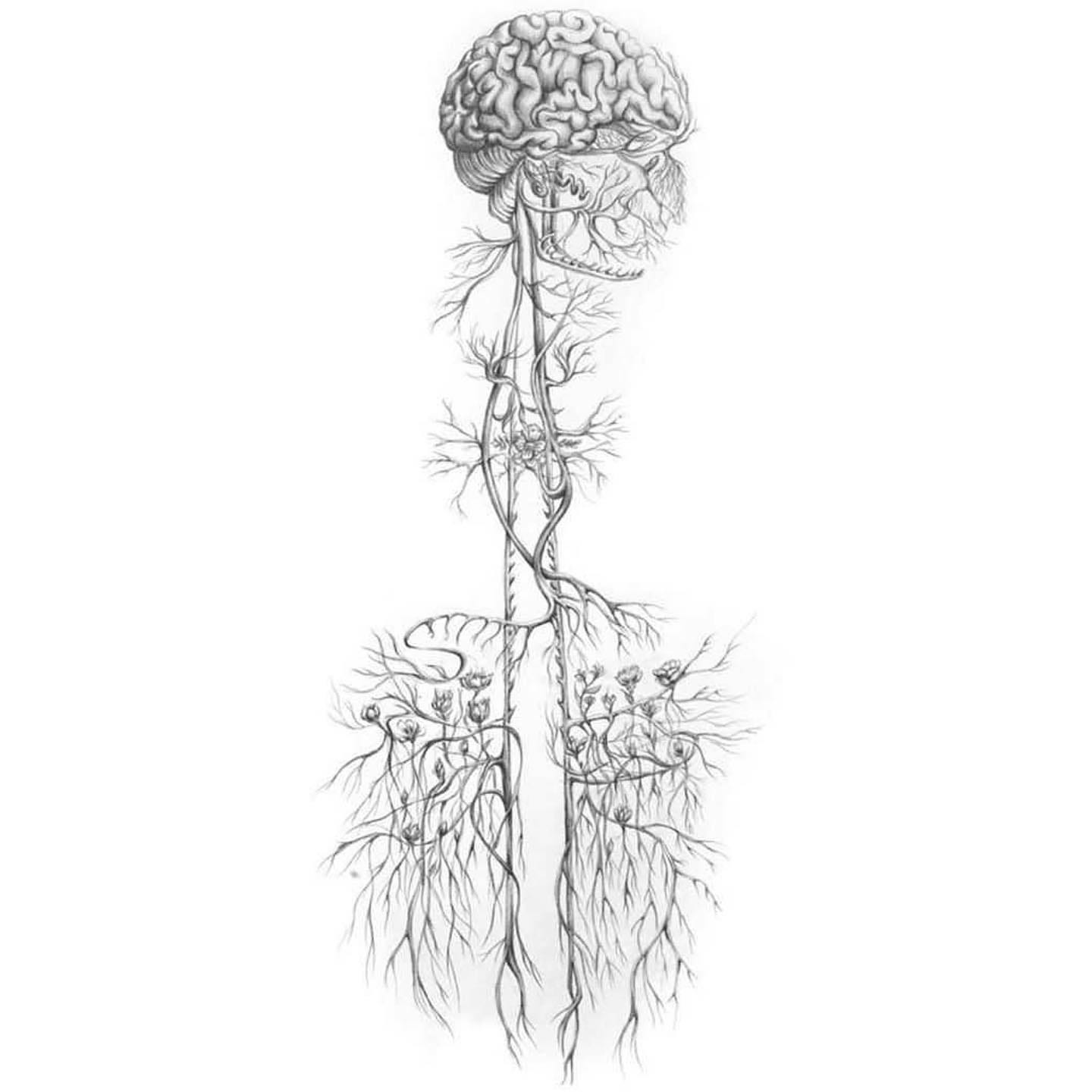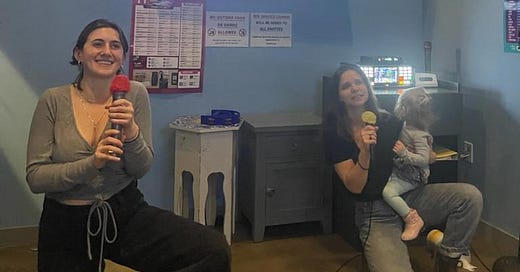hello friends and strangers,
today I want to tell you about singing karaoke last weekend with a couple of my oldest friends1. There is a Korean karaoke place here where you can rent a private room for the low, low price of $35/hour and sing one song after the next without waiting for strangers to finish their song, without the stress of choosing ONE perfect song, AND you can also order delicious ramen, dumplings and beverages delivered to your private karaoke room.
I mean.
Seriously??
This is a yoga newsletter, I know. Just hear me out:
I stood there, mic in hand, preparing to belt out Goodbye Earl in my best country twang, preparing to willingly make an ass of myself, and felt all of my uptight-ness. It wasn't new, karaoke-related uptight-ness, but one that is ever-present. It lives just beneath the surface of all of the other stuff I carry over my mind and my heart each day.
Anyways— I started singing, and that fist of uptight-ness clamped down harder around me. Then I kept singing, and it loosened, eventually falling away entirely. I sang badly, and I danced, and not long after, I felt a thing that I like to call The Effervescent Return— that feeling when all of the shiny, shimmery particles of awareness that usually just buzz and hover around you float back into your body and fizz up and you feel kind of tingly and relaxed and whole again? Do you know what I’m talking about? It is the same feeling I get when I finally settle in to a walk or a run in the woods, without needing to be anywhere else, or when I go to kirtan and chant.
Singing, from an embodied awareness standpoint, pointed out the edginess that I was ignoring, and then nudged me into relaxation and ease. This wasn’t just from the freedom that comes from flagrantly singing loudly and poorly in front of other people— there was an anatomical, scientific thing going on there too, which has to do with the fact that singing and humming naturally lengthen the exhalation, which is down-regulating, and the overall effect that singing and humming have on the Vagus nerve.
The Vagus nerve is part of the autonomic nervous system and the longest cranial nerve in the body. It begins at the brain stem and wanders down and around the face, neck, enervates the lungs, heart, diaphragm, and abdomen, including the stomach, spleen, intestines, colon, liver, and kidneys, and even branches down into the pelvic floor. It is, as physical therapist Maryssa Steffen writes, “neurobiological evidence of the mind-body connection,” and of the gut-brain connection, too (so cool). It’s linked to mood, heart rate, digestion and immune function. Singing, chanting, humming and even gargling stimulates the vagus nerve, which helps to activate the parasympathetic nervous system (PNS) aka the “rest and digest, chill-the-F-out” part of our nervous system.

Movement therapist, artist and educator Bonnie Bainbridge Cohen said her mentor once told her: “you’ll never be able to dance until you can sing, you’ll never be able to sing until you can dance.” 2 They are not talking about artistic proficiency, but rather the connection between the mouth/face, the limbs and the pelvic floor, and the freedom that comes from allowing softness and relaxation into these areas that we normally guard when we are in perpetual fight-or-flight mode. My 20-month old daughter, for example, is unabashed in every sense of the word— she expresses herself freely through unguarded facial expressions, wild movements and vocalization. It seems like every thought, emotion, effort, gesture and feeling is communicated with abandon— she cries, she laughs, she screams, she hurls herself onto the floor in grief or rage. There is no worry about how she may be perceived or whether she “should” feel a certain way, whether she “should” express herself. As we get older, we become more somatically armored. Maybe we develop the habit of policing our facial expressions so’s not to offend or be seen as weird, rude or obtrusive. Singing and chanting is liberating, and it’s something active we can do to invite release into the parts of us that have been guarding against invisible threats and reconnect to our natural self-expression.
Beyond the anatomical, there is a spiritual connection that comes from singing, too. We see singing and chanting used as tools across religions— from Gregorian chants to gospel hymns to yogic chanting— to get closer to god/the universal pulse/something bigger than oneself.
In yoga, we often begin and end class together with a chant of om. Maybe you have not practiced much chanting beyond that singular pre- and post-movement om, but perhaps you felt a little buzz of that Effervescent Return. Writes teacher Linda Johnsen, “Blissfully singing the sacred sounds helps untie the knots at your heart center and clear the mental debris out of the brain’s energy centers.” There are so many beautiful, mysterious chants out there to learn and practice.3
Chanting is also a way of sustaining and expanding our yoga practice— most of us found our way to yoga by falling in love with asana, but that’s just the tip of the yoga iceberg. As we age and change, so must our yoga practice. If, for example, you injure yourself, chanting is a beautiful way to stay in close contact with your practice when you cannot practice asana anymore, or even meditate comfortably.
A lovely, neutral, inclusive chant that you can try, which does not include any holy names or overtly religious sentiments, is:
lokah samastah sukhino bhavantu
(low-KAH, sah-mah-STAH, soo-kee-no, buh-vahn-too)
“may all beings everywhere be happy and free”
Or you could just go out for karaoke night… god is everywhere.
∵ Thanks to everyone who participated in our first meditation for beginners series, it was wonderful to be with you all on the screen. If you were interested in the series but missed it, good news: all of the recordings are available in the good space archive
A quick poll: would you be interested in a monthly virtual meditation group? 20-30 min, some of which would be chatting and gentle movement, then doing a guided meditation together…
∵ Our next good space series for paid subscribers will be a philosophical deep-dive into the yamas and niyamas, and will probably happen in the spring!
∵ FREE WORKSHOP ALERT! Feb 17th at 10:30am EST I’m teaching a workshop all about stress and the pelvic floor via 4th Trimester Physical Therapy. This workshop is for you if you want to be pregnant someday, are currently pregnant, or are postpartum! Send me an email at berlinkrebs@ymail.com for the Zoom info.
∵ Book a private yoga session with me or gift one to a friend who could use it <3
∵ If you’re interested in bringing yoga or meditation into your classroom, workplace, retreat or event, please send me an email at berlinkrebs@ymail.com — this can be virtual or in-person, I love an excuse to travel!
my complete setlist, in case you were wondering:
Right Na Na Na by Akon
If It Makes You Happy by Sheryl Crow
Goodbye Earl by Dixie Chicks
The Way You Love Me by Faith Hill (not my pitch let me tell you)
Speechless by Lady Gaga
Welcome to the Black Parade by My Chemical Romance — a duet with Jenna for our 15 year old selves
If you like getting nerdy about heady, embodied anatomy stuff like “empowering our voice by embodying its embryological beginnings and connection to our perineal body in the center of our pelvic diaphragm,” you can watch Bonnie’s video on the subject. She is amazing, such a trailblazer!
I love listening and chanting along with Krishna Das, he’s on Spotify!






I love vagus nerve content!!!!
This resonates in all sorts of ways! ♥️